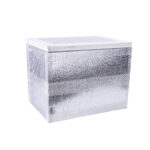Shipping Worldwide Dry Ice and Ice Packs: The Ultimate Guide for 2025
Shipping temperature-sensitive goods like pharmaceuticals, food, and biological samples requires specialized packaging and compliance with global regulations. Dry ice and ice packs are two of the most reliable cooling agents for such shipments. This guide covers essential information on shipping worldwide with dry ice and ice packs, including best practices, benefits, and the latest 2025 trends.
-
What is dry ice, and how does it work for shipping?
-
What are the key differences between dry ice and ice packs for global shipments?
-
What are the best practices for shipping dry ice and ice packs worldwide?
-
How can using dry ice and ice packs benefit your business?
-
What are the latest trends in dry ice shipping for 2025?
What is Dry Ice and How Does It Work for Shipping Worldwide?
Dry ice is the solid form of carbon dioxide (CO2), which sublimates (turns directly from solid to gas) at -78.5°C (-109.3°F). Unlike regular ice, dry ice doesn’t melt into water, making it perfect for shipping temperature-sensitive items without the risk of water damage. It absorbs heat from its surroundings, creating a low-temperature environment that helps maintain the required temperature for perishable goods during transit.
Why Should You Use Dry Ice for Shipping Worldwide?
Dry ice is particularly valuable when shipping products that need to remain frozen. It offers several advantages for businesses:
-
Consistent Temperature Control: Dry ice maintains a steady low temperature for longer periods compared to regular ice, reducing spoilage risks.
-
No Water Damage: Since dry ice sublimates, there’s no risk of water damage to goods, which is especially crucial for pharmaceuticals and food.
-
Global Compatibility: Dry ice is widely accepted for international shipping, ensuring products stay within required temperature ranges during long-distance shipments.
What Are Ice Packs, and When Should You Use Them?
Ice packs are filled with gel or water-based coolants that freeze at specific temperatures, typically around 0°C (32°F). These are suitable for items that need to stay cool but not frozen, such as chocolates, fresh produce, and pharmaceuticals that should not freeze.
Why Choose Ice Packs?
-
Less Regulatory Complexity: Ice packs are not classified as hazardous materials, so they require fewer regulations compared to dry ice.
-
Ideal for Shorter Durations: Ice packs are suitable for shorter shipments and products requiring refrigeration rather than freezing.
Best Practices for Shipping Dry Ice and Ice Packs
Packaging and Ventilation
Proper packaging is critical for both dry ice and ice packs. Always use insulated containers designed to maintain low temperatures and allow for proper ventilation. For dry ice, packaging must allow CO2 gas to escape to avoid pressure buildup, while ice pack containers should be sealed to prevent leakage.
Understanding Dry Ice Weight Limits
Different countries have varying regulations regarding dry ice shipments. Typically, up to 5.5 pounds (2.5 kg) of dry ice can be shipped in a single package. Always check local regulations to ensure compliance.
Correct Labeling
Both dry ice and ice pack shipments require accurate labeling. Dry ice shipments must be marked with “Dry Ice” or “Carbon Dioxide, Solid” and the appropriate UN 1845 number. Include the weight of dry ice and any required hazard symbols.
Safety and Handling Guidelines
-
Dry Ice: Always handle dry ice with insulated gloves to avoid frostbite. Ensure containers are ventilated to allow CO2 gas to escape safely.
-
Ice Packs: Ice packs are easier to handle but should be kept in leak-proof packaging to prevent water from leaking onto the goods.
How Shipping Dry Ice and Ice Packs Benefits Your Business
Using dry ice and ice packs can greatly improve the efficiency of your operations. Here’s how:
Enhanced Product Quality
Shipping with dry ice ensures that products such as frozen food, biological samples, and vaccines stay at their required temperatures, preventing spoilage and preserving their quality.
Expanding Service Offerings
By incorporating dry ice and ice pack shipping, your business can expand into new markets that demand temperature-sensitive shipments, such as the pharmaceutical or biotech industries.
Improved Customer Satisfaction
Speed and efficiency are essential in today’s market. By offering reliable dry ice and ice pack shipping, you can meet customer demands for quick delivery without compromising product quality.
2025 Trends in Dry Ice and Ice Pack Shipping
The cold chain logistics industry is evolving rapidly, and here are some key trends:
Smart Packaging and Monitoring
Smart packaging technologies allow real-time monitoring of temperature fluctuations, humidity, and CO2 levels during shipping. These innovations are helping businesses optimize their cold chain logistics for greater efficiency.
Sustainable Shipping Solutions
As the demand for eco-friendly practices grows, more companies are adopting sustainable packaging materials for dry ice and ice pack shipments. This includes biodegradable materials and reusable coolants.
Global Shipping Partnerships
In 2025, businesses are increasingly partnering with logistics providers specializing in cold chain solutions, which enables safer and more efficient international shipments.
Common FAQs About Shipping Dry Ice and Ice Packs
Q1: Can I use dry ice to ship perishable goods?
Yes, dry ice is perfect for shipping perishable goods that need to remain frozen, such as vaccines, seafood, and frozen food items.
Q2: Do ice packs require special documentation for international shipping?
No, ice packs are not classified as hazardous materials, so they don’t require the complex documentation that dry ice does.
Q3: How do I ensure my dry ice shipments stay within the required temperature range?
Ensure proper packaging, check local regulations for weight limits, and always include proper ventilation for dry ice shipments.
Summary and Recommendations
To successfully ship dry ice and ice packs worldwide, it’s essential to follow best practices for packaging, labeling, and regulatory compliance. These methods not only ensure safe and efficient shipping but also help your business expand its service offerings and enhance customer satisfaction.
About Tempk
At Tempk, we specialize in temperature-controlled logistics solutions, ensuring safe and compliant shipping of temperature-sensitive goods. Our expertise in dry ice and ice pack systems helps businesses navigate the complexities of global cold chain logistics.
Ready to optimize your cold chain operations? Contact Tempk today for expert advice and personalized recommendations on dry ice and ice pack shipping.
























